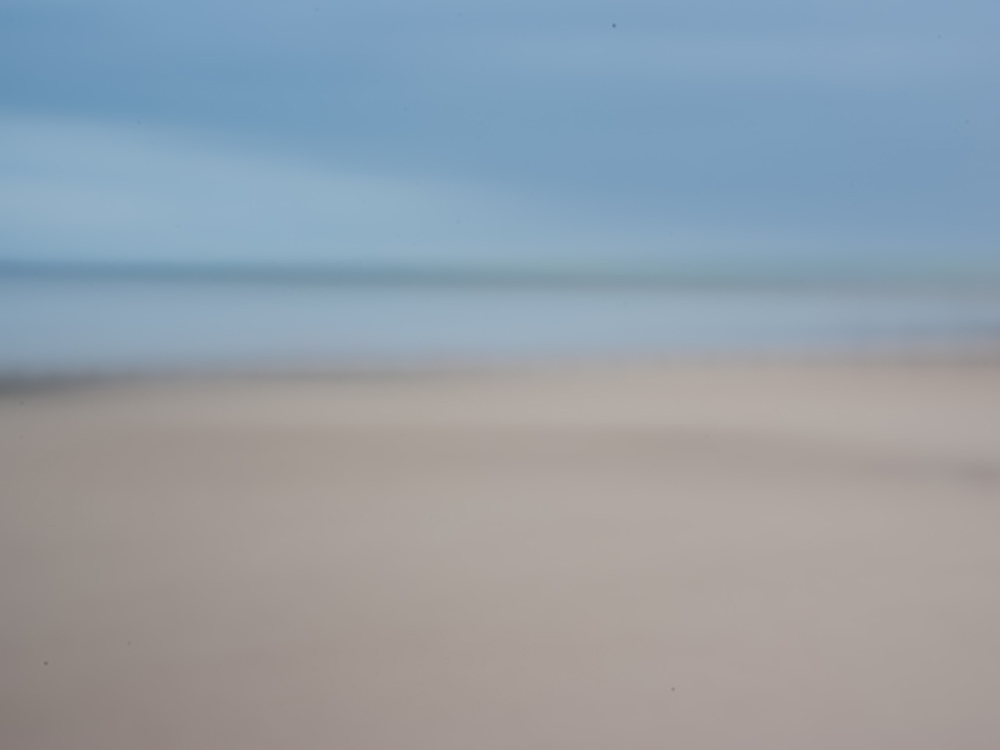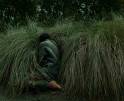Inner Vision: Photography by Blind Artists: Rosita McKenzie
Based on a scene of a beach at night, the sky covering the top half of this abstract photograph is a deep indigo blue. The sand is a warm glowing orange. Long exposure light trails from a bonfire, and other sources of yellow, white and green lights create checkmark-shaped patterns across the image. There is a lit streetlamp to the left.
Throughout the year, particularly in the winter months, Portobello Beach has lots of bonfire events. They are atmospheric occasions, especially when darkness falls. The rhythm and sound of the waves breaking onto the beach close to where people sit help to create a cosy environment not usually associated with the Scottish weather. Families use these opportunities to strengthen their sense of community and friendship, with children playing games and happily enjoying toasted marshmallows.
In Doug Johnstone’s novel Fault Lines, a group of young adults gather around a bonfire relaxing and chilling out. This image reflects what happens both in the story and in reality. It also depicts a rare moment of normality for the main character, the volcanologist Surtsey, when she is feeling relaxed and has briefly forgotten and relinquished her feelings of guilt and anxiety.
I began my photographic career in 2006, some might say, on meeting a somewhat impossible challenge for a totally blind person. Unsurprisingly, I quickly learned I could not proceed using methods laid down by the sighted world. My process and methods had to be different and conducted strictly on my own terms. Self-expression, I passionately believe, is essential to a happy life for everyone and having the opportunity to be ourselves and using whatever method we find easiest, is the key to ongoing contentment and a sense of achievement. Photography is normally seen as focusing on something that already exists in the physical world and clicking the shutter, but I have found my process is the reverse. My photography is the product of matching my internal images and experience to the reality I find outside my own body. Ergo, I impose my images on that interpreted reality to create new stories.
For nearly 20 years, I have been photographically collecting my impressions of Edinburgh’s Portobello Beach and community, using my sense of hearing, smell, touch, and my keen interest in people, and the differences in the day-to-day environment.
Inspired by the crime novel, Fault Lines, written by local author Doug Johnstone, which is set in my hometown of Portobello, Edinburgh, I created ‘Uncanny Portobello’, a collection of abstract images that chime with the surreal aspects of the novel. The action of the novel’s narrative takes place over a period of weeks during the summer months when Portobello Beach and the promenade are busy places to be. My photographs suggest a sense of mystery and otherness surrounding the fictitious volcanic island that dominates the story.
How did I go about creating these photographs? I must admit at first it was a challenge. However, I soon settled on a simple idea. I decided to approach each image individually to visually represent scenes from Fault Lines as accurately as possible. This meant I used several different techniques. The most important of these was focusing my ideas through various lenses. Beginning with the lens of the author’s imagination which then pass through the lens of my own imagination and finally, through the lens of the camera, whether it was my Nikon D80 or a pinhole camera. Included here are three out of 18 photographs from the ‘Uncanny Portobello’ series inspired by Fault Lines. Each photograph represents a significant chapter in the story as far as possible. – Rosita McKenzie, March 2023
Audio recordings by Camila Cavalcante.
I used a pinhole camera to photograph Portobello Beach. The image is intentionally out of focus with smooth beige sand, light blue waveless sea, a dark edge of land on the horizon and lightly clouded sky all blurring into one another in a painterly way. The greyness on the beach forms small uniform shadows which dot across the sand to the sea.
I envisioned from my reading of Fault Lines that Surtsey – due to the double tragedies in her life and heavy use of alcohol and marijuana – was not connected to the real world much of the time. She was often feeling emotionally disconnected and moving through her days in a blurred, dream-like state. To illustrate this emotional and psychological disconnect, I then used an alternative photographic technique to show this part of the story more accurately.
Earth tremors and after-shocks also feature strongly in the storyline. By using a pinhole camera and deliberately moving it as I took these images, helped to create the distortion and a real sense of the effects that I was looking for. In this way, I could photograph something as simple as a seascape and represent it with all the abstractions and subjectivities that the blurred qualities of the image portray. An abstract image like this, also made me connect with the story in a more profound way, because the character was living in an immaterial, psychological world. However, Surtsey was eventually pulled back to reality to face the consequences of her own actions and, later, her profound sense of guilt.
The sea is photographed from above and the water is a deep emerald green with a bright bridge of sunlight coming down from the top edge of the image. The sea is churned turquoise at the bottom of the image, with white foam and small peaks.
I am very pleased with this photograph and delighted with this description of it. When I began my career as a photographic artist, I quickly realised I gained far more by using a camera than I ever anticipated. Creating photographs has always helped me to recall moments, events, passing strangers and previously unfamiliar locations more clearly than I would have done without it. Of course, this is the function of photography that can help everyone. More important for me as a totally blind person, is the fact that I am reminded of the colours I can no longer see, and of what things look like.
The photographic process also helps to ground and focus my creativity and provides evidence that I am able to channel my imagination in constructive ways. It is especially important knowing that the images described are my own and I have a personal connection with every subject taken. This image of the sea is a metaphor not only for the physical secrets the sea hides but for the secrets that have been kept in the story and now are shockingly revealed for everyone to know.
Posts on Lenscratch may not be reproduced without the permission of the Lenscratch staff and the photographer.
Recommended
-
Aaron Rothman: The SierraDecember 18th, 2025
-
Gadisse Lee: Self-PortraitsDecember 16th, 2025
-
Scott Offen: GraceDecember 12th, 2025
-
Izabella Demavlys: Without A Face | Richards Family PrizeDecember 11th, 2025
-
2025 What I’m Thankful For Exhibition: Part 2November 27th, 2025


















































